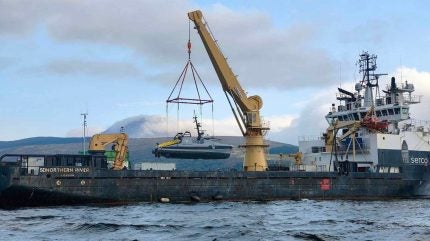
SD Northern River, an offshore supply vessel, facilitated the trial of a prototype autonomous patrol boat intended for mine countermeasures off the east coast of Scotland on 10 December 2024.
While the trial successfully demonstrated the Apollo Maritime Mine Counter Measure used to scan the seabed for various mines, its deployment from Serco Marine System’s largest support ship also proved the utility of commercial platforms to the UK Royal Navy.
Its support gave credence to the belief that the Royal Navy may decide to lean on “commerical platforms as ‘floating bases’ for certain operations,” according a press release issued by the UK’s defence procurement agency, Defence Equipment and Support (DE&S).
Royal Navy needs more support
In the backdrop, the UK Ministry of Defence announced sweeping cuts to its naval force towards the end of November. In one fell swoop, the Defence Secretary John Healey put an end to the life cycle of the Type 23 frigate, HMS Northumberland, and two Albion-class amphibious assault ships.
Faced with a declining surface fleet, the service unveiled a new strategy for a more nimble navy at the beginning of December. As part of its conception, the service will ensure a greater forward presence with fewer ships and sailors. This model – proven over the last several years by the Navy’s Batch 2 River-class vessels – demonstrates “that five ships could do the work of 11.”
Although there is a plan in place for Britain’s surface combatant fleet, the Royal Navy is also struggling with its multi-purpose support ships, which must maintain their combatants at sea in the coming years.
Following cuts to the Albion-class, the service will now rely on less capable Royal Fleet Auxiliary (RFA) ships until the replacement Multi-Role Strike Ship enters service in 2033 at the earliest.
Until then, the RFA’s three Bay-class landing ship docks will fulfill the role of amphibious support vessels, although they are mainly civilian crewed and less capable than the outgoing HMS Albion and HMS Bulwark.

New ‘floating bases’
‘Floating bases’ refer to a number of different naval roles at sea. As SD Northern River is a multi-purpose auxiliary ship, the Navy will likely want to lean on commercial ships for an auxiliary purpose to plug its own capability gap.
As of August 2021, Serco operate nearly 100 vessels ranging in length from 11 metres (m) to 93m and from 12 to 3,600 gross tonnes.
The term also directly refers to ‘bases’, which brings to mind the role of an aircraft carrier, of which the Royal Navy have two Queen Elizabeth-class units. The two carriers however cannot deploy simultaneously.
The relative inactivity of the service’s two aircraft carriers, combined with each suffering mechanical problems that have required repairs, could see each vessel taking turns in being placed in ‘extended readiness’, effectively mothballed by another name.
Both carriers, Healey revealed in a Defense Select Committee session, “are under scrutiny but not in jeopardy,” he said with no further explanation of the semantics. For this reason, the Navy may well lean on commercial ships in this capacity, too.
Additional reporting from Richard Thomas.



